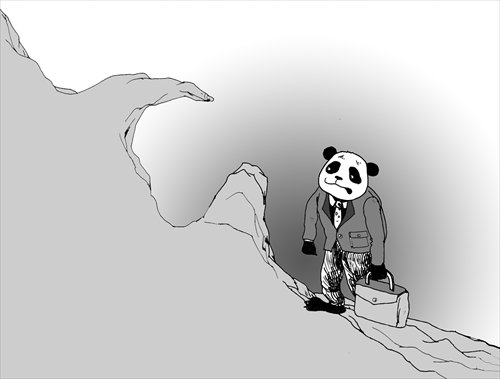Economic transition is challenge for growth

Illustration: Luo Xuan/GT
The Chinese economy has experienced more pressure in the first half of 2016, along with increased external economic risks, such as the UK referendum which has exacerbated financial volatility across the globe.
Amid greater overseas uncertainties, fluctuations in China's economic performance have enlarged as well. Backed by policies to support growth of real estate and infrastructure investment propelled an economic rebound, as reflected in economic statistics in March. However, as relatively loosened policies have become more moderate, some major economic indicators including industrial production, investment and consumption have declined in the second quarter, and investment from the private sector has dropped to a new low, prompting public concerns.
China's transition to a new normal while simultaneously dealing with slowdown in economic growth, difficult structural adjustments, and effects of previous economic stimulus policies, is believed to be a contributor to the economic fluctuations in the first half of 2016. Increased uncertainties in the country's macroeconomic policies and in the overseas economy may have also played a role.
The above influences are expected to persist during the second half of the year. Infrastructure and property investment were the main drivers behind sustaining the economy. But rapid property price increases in first-tier cities have triggered concerns of a bubble, so relevant policies have been tightened since May. Facing such obstacles, sharp decreases in property sales and investment data have occurred, prompting uncertainty on whether real estate market will be able to support economic growth in the second half of the year.
Benefiting from faster approval and enhanced government spending, infrastructure investment has grown at a rapid pace. Additionally, flooding this summer has exposed pockets of insufficient investment on flood defense and drainage, which will enhance infrastructure investment in the relevant areas.
Against the backdrop of cutting excess industrial capacity, investment in the manufacturing sector during the first half of 2016 has continued to decline to new lows. Meanwhile, considering the plan to clean up 345 zombie enterprises over the next three years and reduce the country's coal and steel capacity by 10 percent in two years' time, manufacturing investment is expected to take a downward slide.
While this historic decline in private investment is certainly influenced by the transition in the economic structure along with a reduced return rate on investments, lack of confidence from entrepreneurs may be the driving factor. If so it will be crucial to restore confidence and stabilize expectations in the remaining six months of this year.
Thanks to a rapid increase in household income, China's consumption has remained stable and continues to strengthen growth. But under the current circumstance of declining economic growth and reduced income expectations, a greater increase in consumption is unlikely to be seen in the short run.
Given the grim situation of foreign trade in recent years, the government hasn't set a specific target for imports and exports this year. In addition to increased uncertainty fueled by the Brexit vote, a slowdown in the global economy and a rise in trade protectionism, the situation in the second half of the year is unlikely to pick up.
China's performance for the second half of 2016 is likely to be characterized by increased policy uncertainties. A loosened policy environment is needed to maintain economic growth, but indiscriminate strong stimulus must be avoided to prevent negative side effects.
The monetary policy for the second half is expected to be moderately eased via the combination of targeted monetary measures and regular monetary instruments to sustain sufficient liquidity. Considering China's fiscal deficit target for 2016 has been elevated to a new high of 3 percent of the overall GDP, relevant arrangements are expected to take place regarding unemployment, increasing investment on public services and the issuing of more sovereign debt.
Structural economic reform is anticipated to speed up in the second half of 2016. As a result of the clean up of zombie enterprises, industrial production, employment and consumption are likely to be impacted in the short run, while a reduction in financial leverage is also likely to lead to a short-term liquidity squeeze and shortage of capital. In addition, getting rid of the implicit guarantee on debt repayment by allowing bonds to default will push up relevant costs in the capital market and temporarily reduce market confidence. In this regard, maintaining a certain degree of loosened policy is necessary to stabilize growth, maintain employment and prevent risks, and also help advance China's supply-side reform.
The authors are respectively chief economist and research fellow with Mizuho Securities Asia. bizopinion@globaltimes.com.cn